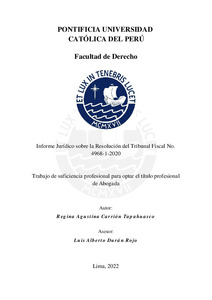| dc.contributor.advisor | Durán Rojo, Luis Alberto | |
| dc.contributor.author | Carrión Tapahuasco, Regina Agustina | |
| dc.date.accessioned | 2022-08-13T03:01:21Z | |
| dc.date.available | 2022-08-13T03:01:21Z | |
| dc.date.created | 2022 | |
| dc.date.issued | 2022-08-12 | |
| dc.identifier.uri | http://hdl.handle.net/20.500.12404/23069 | |
| dc.description.abstract | En el presente informe se analizan los problemas jurídicos identificados en la Resolución del
Tribunal Fiscal No. 4968-1-2020, los cuales están vinculados a la aplicación de la facultad de
calificación del hecho imponible de la SUNAT, regulada en el primer y último párrafo de la
Norma XVI. De ese modo, se buscará determinar si SUNAT aplicó realmente su facultad de
calificación al caso materia de controversia, el cual versa sobre tres operaciones societarias que
simularían una enajenación de acciones. De igual modo, se analizará si aun en el supuesto de las
operaciones recalificadas como enajenación, se determinó adecuadamente la deuda tributaria e
identificó al agente de retención obligado al pago de esta.
Considerando los argumentos expuestos en la Resolución analizada, la legislación,
jurisprudencia y doctrina, se concluye que en el caso no se aplicó la facultad de calificación sino
criterios propios de la cláusula antielusiva general. Asimismo, se concluye que no se determinó
de forma adecuada la deuda tributaria y tampoco se identificó correctamente al sujeto
responsable del pago de la deuda tributaria. | es_ES |
| dc.description.abstract | This report analyzes the legal problems identified in Tax Court Resolution No. 4968-1-2020,
which are derived from the exercise of the Tax Administration's taxable event characterization
faculty, regulated in the first and last paragraph of Rule XVI. Thus, it will be sought to
determine whether SUNAT really applied its characterization faculty to the case, which involves
three corporate transactions that would simulate a transfer of shares. Likewise, Likewise, it will
be analyzed whether even in the case of transactions recharacterized as alienation, the tax debt
was adequately determined, and the withholding agent responsible to pay it was identified.
Considering the arguments set forth in the Resolution analyzed, the legislation, jurisprudence
and doctrine, it is concluded that the characterization faculty was not applied in this case, but
rather the criteria of the General Anti-avoidance Rule. Likewise, it is concluded that the tax debt
was not adequately assessed and the withholding agent responsible for the payment of the tax
debt was not correctly identified. | es_ES |
| dc.language.iso | spa | es_ES |
| dc.publisher | Pontificia Universidad Católica del Perú | es_ES |
| dc.rights | info:eu-repo/semantics/closedAccess | es_ES |
| dc.subject | Deuda--Legislación--Perú | es_ES |
| dc.subject | Impuestos--Legislación--Perú | es_ES |
| dc.subject | Derecho tributario--Perú | es_ES |
| dc.title | Informe Jurídico sobre la Resolución del Tribunal Fiscal No. 4968-1-2020 | es_ES |
| dc.type | info:eu-repo/semantics/bachelorThesis | es_ES |
| thesis.degree.name | Abogado | es_ES |
| thesis.degree.level | Título Profesional | es_ES |
| thesis.degree.grantor | Pontificia Universidad Católica del Perú. Facultad de Derecho. | es_ES |
| thesis.degree.discipline | Derecho | es_ES |
| renati.advisor.dni | 09552537 | |
| renati.advisor.orcid | https://orcid.org/0000-0001-6200-6887 | es_ES |
| renati.author.dni | 70820477 | |
| renati.discipline | 215106 | es_ES |
| renati.juror | Adriazola Burga, Stephanie Alexa | es_ES |
| renati.juror | Sheppard Castillo, Karen Paola | es_ES |
| renati.level | https://purl.org/pe-repo/renati/level#tituloProfesional | es_ES |
| renati.type | https://purl.org/pe-repo/renati/type#trabajoDeSuficienciaProfesional | es_ES |
| dc.publisher.country | PE | es_ES |
| dc.subject.ocde | https://purl.org/pe-repo/ocde/ford#5.05.01 | es_ES |





